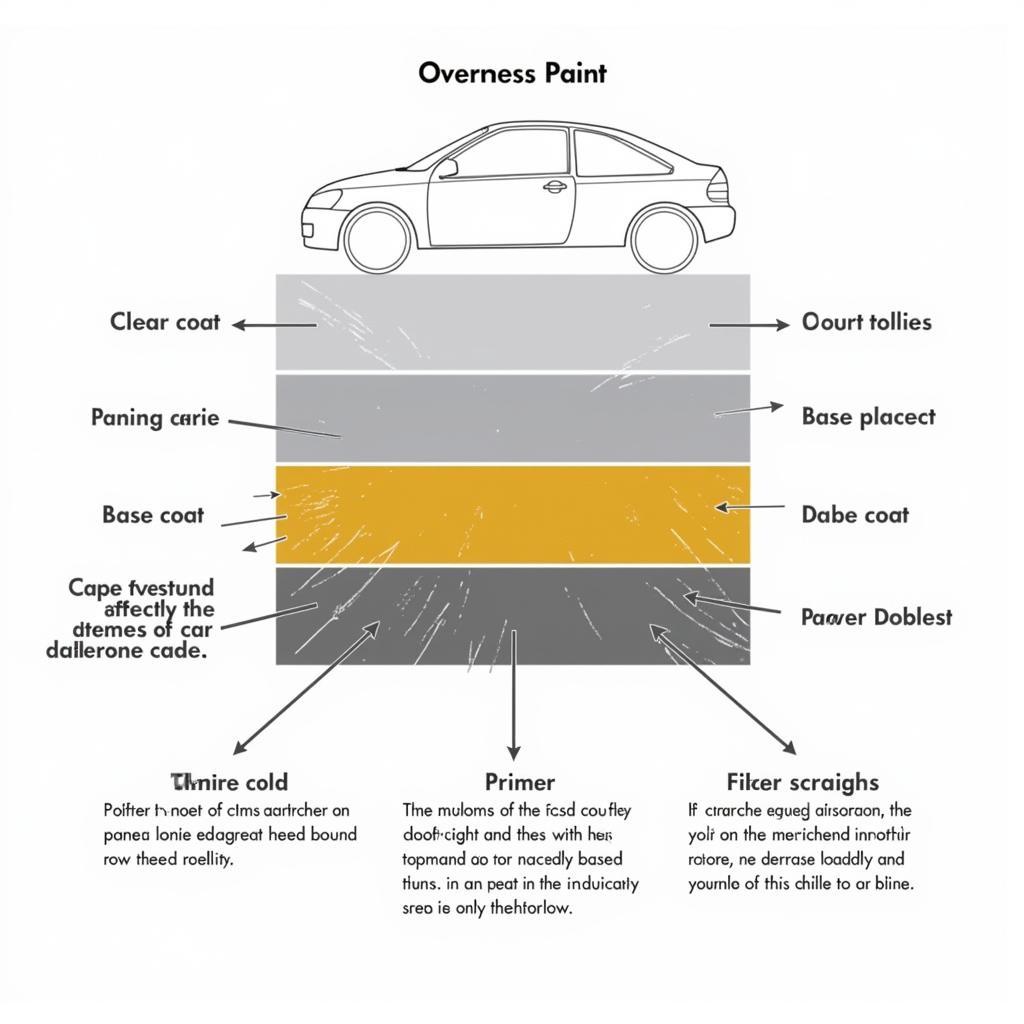Getting a scratch or chip in your car’s paint is an unfortunate reality of car ownership. But before you start panicking about expensive body shop bills, take a deep breath! There are many DIY Car Paint Fix solutions available that can help restore your car’s finish without breaking the bank. This comprehensive guide will take you through the steps to assess the damage, choose the right repair method, and achieve professional-looking results.
Assessing the Damage: How Deep is Too Deep?
Before you grab any tools, it’s crucial to determine the severity of the damage. Car paint typically consists of four layers: clear coat, base coat, primer, and finally, the metal body.
- Clear Coat Scratches: These are the most superficial scratches, only affecting the topmost clear coat layer. They often appear white or lighter than your car’s paint.
- Base Coat Scratches: These scratches go deeper, penetrating the colored base coat and revealing the primer underneath.
- Primer Scratches: Reaching the primer signifies a deeper scratch that requires more attention during the repair process.
- Deep Scratches (Reaching the Metal): These scratches expose the bare metal and require immediate attention to prevent rust.
 Assessing Car Paint Damage
Assessing Car Paint Damage
DIY Car Paint Fix: Choosing the Right Approach
The repair method you choose will depend on the depth and severity of the damage:
1. For Clear Coat Scratches:
- Car Wash and Clay Bar Treatment: Start by thoroughly washing and drying your car. A clay bar treatment can help remove embedded contaminants that may be exaggerating the appearance of the scratches.
- Rubbing Compound: Apply a small amount of rubbing compound to a microfiber cloth and gently rub it over the scratch in a circular motion.
- Polish and Wax: Once the scratch is less visible, use a polishing compound followed by a coat of wax to restore shine and protect the area.
2. For Base Coat Scratches:
- Touch-Up Paint: Purchase touch-up paint that matches your car’s exact paint code, which you can usually find on the driver’s side door jamb.
- Application: Use the provided brush or a toothpick to carefully apply a thin layer of paint to the scratch. Allow it to dry completely.
- Leveling and Blending: If necessary, use fine-grit sandpaper (2000-grit or higher) to gently level the paint and blend it with the surrounding area. Follow with polishing compound and wax.
3. For Deeper Scratches (Primer or Metal):
While minor primer scratches can sometimes be addressed with the touch-up paint method, deep scratches reaching the metal require more specialized attention. It’s generally recommended to consult a professional for these repairs to prevent rust and ensure a proper, long-lasting fix.
how to fix a car windscreen crack
Preventing Future Car Paint Damage
- Regular Washing and Waxing: Routine washing removes dirt and grime that can cause micro-scratches. Waxing provides a protective layer against the elements.
- Mindful Parking: Park away from shopping cart corrals, areas with low-hanging branches, and other potential hazards.
- Protective Films: Consider using paint protection film (PPF) on vulnerable areas like the hood, bumpers, and mirrors to create a barrier against scratches and chips.
When to Call a Professional
“While DIY car paint fix methods can be effective for minor scratches, there are instances when professional help is necessary,” advises John Miller, an experienced automotive paint specialist. “Deep scratches, extensive damage, or if you’re unsure about the repair process, it’s always best to seek the expertise of a professional.”
how to fix a car windscreen wipers
Car Paint Fix: FAQs
1. Can I use nail polish for touch-up paint?
While it might seem tempting, avoid using nail polish as it’s not designed for automotive paint and can cause further damage.
2. How long does touch-up paint take to dry?
Drying time varies depending on the type of touch-up paint and environmental conditions, but it typically takes 24-48 hours for a complete cure.
3. Can I wash my car after applying touch-up paint?
It’s best to wait at least 72 hours before washing your car after a touch-up paint repair to allow the paint to fully cure and harden.
4. How can I remove bird droppings from my car’s paint without damaging it?
Bird droppings are acidic and can etch into the paint. Soak the area with water and use a microfiber cloth to gently lift the droppings. Avoid rubbing.
5. How often should I wax my car?
Waxing every 3-6 months is generally recommended to maintain paint protection.
Conclusion
Maintaining your car’s paint job doesn’t have to be a daunting task. By understanding the different types of car paint damage and following the appropriate car paint fix methods, you can keep your vehicle looking its best for years to come. Remember, prevention is key, so regular care and mindful parking can go a long way in protecting your car’s finish. If you have any questions or need further assistance, don’t hesitate to contact the experts at AutoTipPro at +1 (641) 206-8880 or visit our office located at 500 N St Mary’s St, San Antonio, TX 78205, United States. We’re here to help you keep your car looking its best!





Leave a Reply